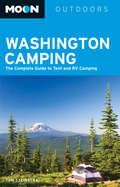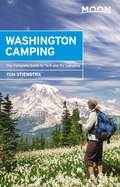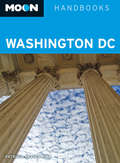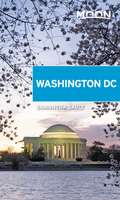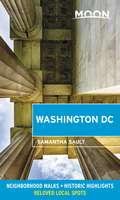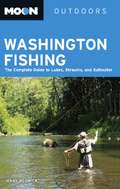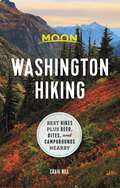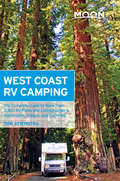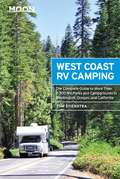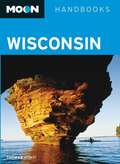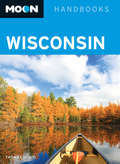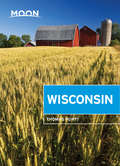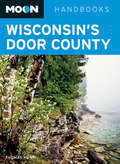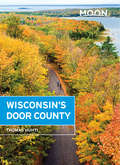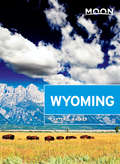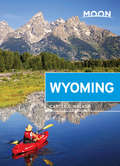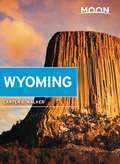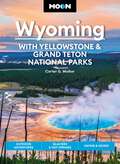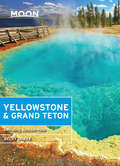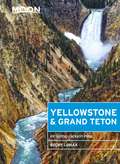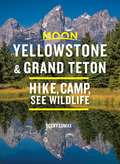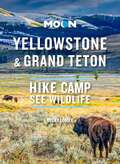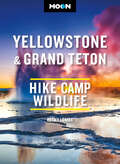- Table View
- List View
Moon Washington Camping
by Tom StienstraTop-selling outdoors writer Tom Stienstra covers the best camping in Washington state, including notable campsites around the Columbia River Gorge, Mount Rainier, the San Juan Islands, and Olympic National Park. Stienstra provides easy-to-follow maps with driving directions to each campground, along with camping options ranging from secluded alpine hike-ins to convenient roadside stopovers. Complete with expert tips on gear, safety and first aid, weather, and camping with kids, Moon Washington Camping gives travelers the tools they need to create a more personal and memorable camping experience.
Moon Washington Camping: The Complete Guide to Tent and RV Camping (Moon Outdoors)
by Tom StienstraMoon Travel Guides: Your Adventure Starts HereWhether you're parking the RV or camping in secluded wilderness, explore the great outdoors of the Evergreen State with Moon Washington Camping. Inside you'll find:A Campsite for Everyone: A variety of campgrounds and RV parks, from family-friendly car camping to secluded hike-ins, including dog-friendly and wheelchair accessible optionsRatings and Essentials: All campsites are rated on a scenic scale and marked with amenities like restrooms, trailhead access, picnic areas, laundry, piped water, showers, and playgroundsRecreation Highlights: Discover nearby hiking, swimming, fishing, water-skiing, whitewater rafting, hot springs, and options for winter sportsMaps and Directions: Easy-to-use maps and detailed driving directions for each campgroundTrusted Advice: Expert outdoorsman Tom Stienstra is always on the move, having traveled more than a million miles across Washington and the West over the past 25 yearsTips and Tools: Essentials like equipment, food and cooking, first aid, and insect protection, as well as background information on the climate, landscape, and history of the campsitesComprehensive Coverage: Moon Washington Camping covers the Olympic Peninsula and the Washington Coast, Seattle and Puget Sound, the Northern and Southern Cascades, Northeastern Washington, the Columbia River Gorge and Mount Rainier, and Southeastern WashingtonWhether you're a veteran or a first-time camper, Moon's comprehensive coverage and trusted advice will have you gearing up for your next adventure.Sticking to the RV? Try Moon West Coast RV Camping. Can't get enough of the Pacific Northwest? Try Moon Oregon Camping or Moon Olympic Peninsula.
Moon Washington DC
by Patricia Nevins KimeJournalist Patricia Nevins Kime welcomes travelers to iconic, history-rich Washington D. C. with this thorough guide, covering everything from the city's vibrant downtown scene to its stately Foggy Bottom district. Kime offers interesting trip ideas for every kind of experience, including Top 10 Off-the-Mall Delights, Fun and Free in D. C. , and Washington's Winning Theaters. From experiencing the thrill of the National Mall to catching a ballgame at Nationals Park,Moon Washington DCgives travelers the tools they need to create a more personal and memorable experience.
Moon Washington DC (Travel Guide)
by Samantha SaultHistory, politics, and the world's best free museums: DC is a bustling powerhouse of a city. From strolling the National Mall to hobnobbing at happy hour, get to know the capital with Moon Washington DC.Navigate the Neighborhoods: Follow one of our guided neighborhood walks through Penn Quarter, Dupont Circle, U Street, Adams Morgan, and moreExplore the City: Snap the perfect photo of the Washington Monument, tour the U.S. Capitol, and explore the incredible Smithsonian museums like the African American History Museum or the Newseum. Catch a whiff of the fragrant cherry blossoms in the spring, rent a boat and paddle along the Potomac, or shop the boutiques in GeorgetownGet a Taste of the City: Chow down on a late-night half-smoke at Ben's Chili Bowl or grab brunch and a new book from Busboys and Poets. Enjoy Michelin-starred seafood at a waterfront restaurant, order up a Chesapeake crab cake, and enjoy the city's diversity of authentic fare from Ethiopia, Afghanistan, the Philippines, and moreBars and Nightlife: Watch a groundbreaking performance at the Woolly Mammoth Theatre Company, catch a live band at the 9:30 Club, or dance to a DJ set at the Black Cat. Sip scotch where former presidents once did, try a five-course cocktail tasting menu, or kick back with a beer and fries at a quintessential DC dive barLocal Advice: Local journalist Samantha Sault shares her love of the nation's capital Strategic, Flexible Itineraries including the three-day best of DC, a weekend with kids, and more, plus day trips to Old Town Alexandria, Annapolis, Easton, and Shenandoah National ParkTips for Travelers including where to stay and how to navigate the Metro, plus advice for international visitors, LGBTQ travelers, seniors, travelers with disabilities, and families with childrenMaps and Tools like background information on the history and culture of DC, full-color photos, color-coded neighborhood maps, and an easy-to-read foldout map to use on the goWith Moon Washington DC's practical tips and local insight, you can experience the city your way.Expanding your trip? Check out Moon Maryland, Moon Virginia, or Moon Chesapeake Bay. Visiting more of America's best cities? Try Moon Boston or Moon Chicago.
Moon Washington DC: Neighborhood Walks, Historic Highlights, Beloved Local Spots (Travel Guide)
by Samantha SaultFrom strolling the National Mall to hobnobbing at happy hour, get to know the nation's capital with Moon Washington DC. Navigate the Neighborhoods: Follow one of our guided neighborhood walks through the National Mall, Dupont Circle, U Street, and moreExplore the City: Snap the perfect photo of the Washington Monument, stand where MLK delivered his "I Have a Dream" speech, and visit the Tomb of the Unknown Soldier in Arlington National Cemetery. Walk the halls of Frederick Douglass's home, journey through the incredible Smithsonian museums, or tour the U.S. Capitol from dome to crypt. Paddleboat along the Potomac during cherry blossom season and shop the boutiques in GeorgetownGet a Taste of DC: Chow down on a late-night half-smoke at Ben's Chili Bowl or grab brunch and a new book from Busboys and Poets. Dig into diverse, authentic fare from Ethiopia, Afghanistan, the Philippines, and more, savor Michelin-starred seafood at a waterfront restaurant, or order up a Chesapeake crab cake at a neighborhood jointBars and Nightlife: Watch a groundbreaking performance at the Woolly Mammoth Theatre Company, catch a live band at the 9:30 Club, or dance to a DJ set at the Black Cat. Sip scotch where former presidents once did, try a five-course cocktail tasting menu, or kick back with a beer and fries at a quintessential DC dive barLocal Advice: DC journalist Samantha Sault shares her love of the nation's capitalStrategic, Flexible Itineraries including the three-day best of DC, four days with kids, and day trips to Alexandria, Annapolis and Easton, and Shenandoah National ParkTips for Travelers including where to stay and how to navigate the Metro, plus advice for international visitors, LGBTQ+ travelers, seniors, travelers with disabilities, and families Maps and Tools like background information on the history and culture of DC, full-color photos, color-coded neighborhood maps, and an easy-to-read foldout map to use on the goWith Moon Washington DC's practical tips and local insight, you can experience the best of the city.Expanding your trip? Check out Moon Virginia & Maryland. Visiting more of America's cities? Try Moon Boston or Moon New York City.
Moon Washington Fishing: The Complete Guide to Lakes, Streams, and Saltwater
by Terry RudnickWashington native Terry Rudnick knows the best fishing spots in the Evergreen State, from the marine waters of the San Juan Islands-just a short trip from Seattle-to the remote lakes of Northeastern Washington. Full of detailed descriptions of over 600 fishing locations,Moon Washington Fishingleads anglers to the best lakes, reservoirs, rivers, and coasts that the state has to offer, and it includes pages' worth of Rudnick's knowledgeable fishing tips and advice. Complete with helpful regional maps and thorough directions for each location,Moon Washington Fishingprovides all the necessary tools to head outdoors.
Moon Washington Hiking: Best Hikes plus Beer, Bites, and Campgrounds Nearby
by Craig HillCraggy coastal cliffs, towering active volcanoes, and cascading waterfalls: wherever you turn in Washington, adventure awaits. Pack a lunch, lace up your boots, and hit the trails with Moon Washington Hiking. Inside you'll find:Diverse Hiking Options: Whether you plan to take leisurely lakeside walks or challenging journeys around Mount Pilchuck, enjoy outdoor getaways ranging from easy day hikes to multi-day backpacking tripsFind Your Hike: Looking for something specific? Choose from strategic lists of the best hikes for breathtaking waterfalls, spring wildflowers, or hiking with your dog, plus a breakdown of the best hikes by seasonThe Top Outdoor Experiences: Pick alpine wildflowers in a meadow along Mount Rainier's Skyline Trail, or wander through a dense, green rain forest in Olympic National Park. Venture across a suspension bridge to breathtaking canyon views, and glimpse seals, eagles, and deer at a wildlife reserve. Catch a vibrant sunset from a beach dotted with sea stacks, or explore an underground lava tube Nearby Fun: Relax post-hike at a local brewery, savor a plate of fresh oysters, and stargaze before bed at a nearby campgroundEssential Planning Details: Each hike is described in detail and marked with round-trip distance and hiking time, difficulty, terrain type, elevation gain, and access pointsMaps and Directions: Find easy-to-use maps, driving directions to each trailhead, and details on where to parkExpert Advice: Longtime hiker Craig Hill shares his local secrets, unique tips, and honest opinions of each trailTips and Tools: Advice on gear, first aid, and camping permits, plus background information on climate, landscape, and wildlifeWhether you're a veteran or a first-time hiker, Moon's comprehensive coverage and local expertise will have you gearing up for your next adventure.Hitting the road? Check out Moon Pacific Northwest Road Trip!
Moon Washington State: National Parks, Local Food & Wine, Year-Round Recreation (Moon U.S. Travel Guide)
by Marissa Pedersen Moon Travel GuidesStunning coastline, seaside towns, and a breathtaking array of natural wonders: Experience the best of the Evergreen State with Moon Washington State. Inside you'll find:Flexible itineraries, whether you're checking out the national parks, visiting the scenic Columbia River Gorge, or road-tripping the whole state Can't-miss experiences and unique activities: Watch the fishmongers at Pike Place Market, enjoy panoramic views from the iconic Space Needle, or visit the charming towns of the San Juan Islands. Sample world-class wines in Walla Walla, savor fresh seafood, and soak up the atmosphere in a cozy coffee shop Outdoor adventures: Hike through wildflower meadows in Mt. Rainier National Park, stroll through the lush Hoh Rainforest, and go sea kayaking in Friday Harbor. Take a whale watching trip, marvel at the varied landscapes of the North Cascades Scenic Byway, or bike along the Spokane River Expert insight from Washington local Marissa Pedersen on when to go, where to stay, and how to get around Full-color photos and detailed maps throughoutThorough background information on the culture, landscape, climate, and wildlife, plus handy recommendations for international visitors, families with kids, travelers of color, solo travelers, and more Focused coverage of Seattle, the Olympic Peninsula, the San Juan Islands, the North Cascades, Mount Rainier and the South Cascades, the Columbia River Gorge, and Eastern Washington With Moon's expert tips and local know-how, you can experience the best of Washington. Sticking to one spot? Try Moon Olympic Peninsula or Moon San Juan Islands. Looking for outdoor adventure? Check out Moon Pacific Northwest Hiking.About Moon Travel Guides: Moon was founded in 1973 to empower independent, active, and conscious travel. We prioritize local businesses, outdoor recreation, and traveling strategically and sustainably. Moon Travel Guides are written by local, expert authors with great stories to tell—and they can't wait to share their favorite places with you. For more inspiration, follow @moonguides on social media.
Moon West Coast RV Camping
by Tom StienstraAward-winning author Tom Stienstra covers more than 1,800 RV parks and campgrounds throughout Washington, Oregon, and California in Moon West Coast RV Camping. Stienstra provides a range of outdoor options that appeal to campers with kids, pets, or recreational equipment, as well as those looking for a beachfront, natural springs, or island retreat. Stienstra also includes his top picks for the Prettiest Lakes, Best Spots for Wildlife-Viewing, and Best Locations for Fishing. With a variety of RV locations, helpful hints, and suggestions, Moon West Coast RV Camping gives travelers the tools they need to create a more personal and memorable camping experience.
Moon West Coast RV Camping: The Complete Guide to More Than 2,300 RV Parks and Campgrounds in Washington, Oregon, and California (Moon Outdoors)
by Tom StienstraPark your RV anywhere from Mission Bay near San Diego to Orcas Island near the Canadian border, and immerse yourself in the wild spirit of the West Coast with Moon West Coast RV Camping. Inside you'll find:A Campsite for Everyone: A variety of RV parks and campgrounds from scenic state parks to convenient roadside stopovers, including dog-friendly and wheelchair accessible optionsRatings and Essentials: All campsites are rated on a scenic scale and marked with amenities like restrooms, trailhead access, picnic areas, laundry, piped water, showers, and playgroundsRecreation Highlights: Discover nearby waterfalls, beaches, historic sites, hot springs, wildlife, and moreMaps and Directions: Easy-to-use maps and detailed driving directions for each campgroundTop RV Parks and Campgrounds: Lists like "Best for Families," "Best for Fishing," and "Best for Hiking" help you choose where to camp in Washington, Oregon, and CaliforniaTrusted Advice: Expert outdoorsman Tom Stienstra is always on the move, having traveled more than a million miles across Washington, Oregon, and California for the past 25 yearsTips and Tools: Essentials like equipment, recreation, first aid, and insect protection, as well as background on the climate, landscape, and history of the campsitesWhether you're a veteran or first-time RV camper, Moon's comprehensive coverage and practical advice will have you gearing up for your next adventure.Sticking to one state? Try Moon California Camping or Moon Oregon Camping. Cruising down the PCH? Check out Moon Pacific Coast Highway Road Trip.
Moon Wisconsin: 2011
by Thomas HuhtiBorn and bred "Cheesehead" Thomas Huhti offers an insider's view of Wisconsin, from the bars and pubs of Madison to the beaches and water parks of the Wisconsin Dells. Huhti is a perfect tour guide, providing unique trip ideas such as Wisconsin Outdoors Adventure and the Frank Lloyd Wright Tour. Packed with information on dining, transportation, and accommodations, this handbook has lots of options for a range of travel budgets. With advice on dining in Milwaukee and exploring the scenic lakeside towns of Door County, Moon Wisconsin gives travelers the tools they need to create a more personal and memorable experience.
Moon Wisconsin: 2014
by Thomas HuhtiBorn and bred "Cheesehead" Thomas Huhti offers an insider's view of Wisconsin, from the bars and pubs of Madison to the beaches and water parks of the Wisconsin Dells. Huhti is a perfect tour guide, providing unique trip ideas such as the Frank Lloyd Wright Tour. Packed with information on dining, transportation, and accommodations, this handbook has many options for a range of travel budgets. With advice on dining in Milwaukee and exploring the scenic lakeside towns of Door County, Moon Wisconsin gives travelers the tools they need to create a more personal and memorable experience.
Moon Wisconsin: Including Door County (Travel Guide)
by Thomas HuhtiDiscover Wisconsin with Moon Travel Guides!From lush forests and fertile farms to rushing rivers and tranquil lakes, experience Wisconsin's classic Midwestern charm with Moon Wisconsin.What you'll find in Moon Wisconsin:Strategic itineraries for any budget and timeline, from a long weekend in Milwaukee or Madison to a week-long getaway to Door CountyDetailed maps and handy reference photos throughoutCurated trip advice for history buffs, foodies, outdoor adventurers, and moreTop attractions and off-beat ideas for making the most of your trip: Check out a typical Wisconsin dairy farm and sample fresh wheels of cheese, or let the kids try their hand at churning their own butter. Kayak to sea caves, cycle through rolling hills filled with apple orchards, or hike around a secluded island. Hit the slopes at a ski resort, go snowmobiling across a frozen lake, or explore unique glacial topography on the Ice Age National Scenic Trail. Wander Milwaukee's historic downtown, check out the Harley-Davidson museum, and unwind with a locally brewed craft beerThe best road trips in Wisconsin, including the state's designated "Rustic Roads"Honest advice from native "cheesehead" Thomas Huhti on when to go, what to pack, and where to stay, from luxe hotels, to historic lodges and lakeside cabinsRecommendations for getting to Wisconsin and getting around, by plane, train, bus, or car (or even boat!)Thorough background on the culture, weather, wildlife, outdoor recreation safety, and historyWith Moon's expert advice, diverse activities, and local insight into the best of Wisconsin, you can plan your trip your way.Can't get enough of Wisconsin? Try Moon Wisconsin's Door County. For more Midwestern adventures, try Moon Minneapolis & St. Paul or Moon Michigan.
Moon Wisconsin: Lakeside Getaways, Outdoor Recreation, Bites & Brews (Travel Guide)
by Thomas HuhtiFrom majestic forests and verdant farms to rushing rivers and tranquil lakes, experience the Badger State's classic Midwestern charm with Moon Wisconsin. Inside you'll find:Strategic itineraries, from a weekend in Milwaukee or Madison to a week-long getaway to Door County, with advice for architecture buffs, foodies, families, outdoor adventurers, and more The top activities and unique experiences: Museum-hop in trendy Milwaukee, discover the joys of the open road at the Harley-Davidson museum, and savor the laidback college town vibe in Madison. Check out a typical Wisconsin dairy farm and sample fresh bites of cheese or learn how to churn butter with the whole family. Dig in at a Friday night fish fry and unwind with a locally-brewed craft beer in a historic taproom. Kayak to sea caves, cycle through rolling hills of apple orchards, or hike the rugged cliffs of Devil's Lake The best road trips in Wisconsin, including the state's designated Rustic Roads Honest advice from native cheesehead Thomas Huhti on when to go, what to pack, and where to stay, from luxe hotels to historic lodges and lakeside cabins Full-color photos and detailed maps throughoutRecommendations for getting to Wisconsin and getting around, by plane, train, bus, or car (or even boat!) Thorough background on the culture, weather, wildlife, outdoor recreation safety, and history With Moon's practical tips and local insight, you can experience the best of Wisconsin. For more Midwestern adventures, try Moon Ohio or Moon Michigan. About Moon Travel Guides: Moon was founded in 1973 to empower independent, active, and conscious travel. We prioritize local businesses, outdoor recreation, and traveling strategically and sustainably. Moon Travel Guides are written by local, expert authors with great stories to tell—and they can't wait to share their favorite places with you. For more inspiration, follow @moonguides on social media.
Moon Wisconsin's Door County
by Thomas HuhtiWisconsin native Thomas Huhti knows the best way to experience Door County, from enjoying outdoor recreation on Lake Michigan to touring the local wineries. In Moon Wisconsin's Door County, Huhti offers recommendations for the region's must-see attractions and activities, and he also includes trip ideas like A Perfect Week in Door County. Whether you're there to visit Cana Island Lighthouse or to canoe around a remote island, Moon Wisconsin's Door County gives you the tools you need to create a more personal and memorable experience.This ebook and its features are best experienced on iOS or Android devices and the Kindle Fire.
Moon Wisconsin's Door County (Travel Guide)
by Thomas HuhtiMoon Travel Guides: Make Your Escape!Soak up stunning coastlines, picturesque villages, and classic Midwestern charm with Moon Wisconsin's Door County.What you'll find in Moon Wisconsin's Door County:Strategic itineraries for every budget and timeline, from a weekend getaway to a week-long trip, curated for outdoor adventurers, foodies, history buffs, and moreMust-see attractions and off-beat ideas for making the most of your trip: Spend the day cycling through forests and along rugged shorelines, or hiking to extraordinary caves and historic lighthouses. Unwind at a charming B&B, or wake up to a refreshing breeze at a beach-side campground. Sign up for a scuba dive into Lake Michigan to see perfectly preserved shipwrecks, or island-hop the bay by kayak or canoe. Peruse local art galleries or the fascinating Maritime Museum, and sample local cheeses and fresh cherries. Pick up a bottle of Door County wine, and find the best spots to sit by the water and watch the sunsetHonest advice from Wisconsin native Thomas Huhti on when to go, what to pack, how to get around, and where to stay, from cozy lakeside inns to secluded island campsitesFull coverage of Door County including Sturgeon Bay, Washington and Rock Islands, Sheboygan, Fond du Lac, and more Coverage of gateway cities like Milwaukee and Madison Detailed maps and helpful reference photos throughoutThorough background on the culture, weather, wildlife, and historyWith Moon Wisconsin's Door County's practical advice, myriad activities, and local insight on the best things to do and see, you can plan your trip your way.Exploring more of the Midwest? Try Moon Minneapolis & St. Paul or Moon Michigan's Upper Peninsula. Headed North? Try Moon Ontario.
Moon Wyoming
by Carter G. WalkerFreelance writer and editor Carter G. Walker introduces you to the best of Wyoming, from the beauty of Yellowstone National Park to the art scene and high style of Jackson Hole and Cody. Walker has plenty of unique trip ideas to offer, including Where the Wild Things Are and Small Town Rodeos: The Biggest Parties in the West. Whether you're looking to climb Devils Tower or to spot a moose in Grand Teton National Park, Moon Wyoming gives you the tools you need to create a more personal and memorable experience.
Moon Wyoming: Including Yellowstone And Glacier National Parks (Travel Guide)
by Carter G. WalkerDiscover Wyoming with Moon Travel Guides!Explore sweeping plains, glitzy resort towns, and down-home dude ranches with Moon Wyoming.What you'll find in Moon Wyoming:Full coverage of the best of Wyoming, including Yellowstone National Park, Grand Teton National Park, and Devils TowerStrategic itineraries curated for history buffs, wild west enthusiasts, outdoor adventurers, and moreDetailed maps and handy reference photos throughoutMust-see attractions and off-beat ideas for making the most of your trip: Hike through Yellowstone's majestic wilderness, spot bison, elk, bears, or wolves, and marvel at the legendary Old Faithful. Go whitewater rafting or kayaking, ride a gondola all the way up to jaw-dropping mountain-top views, or ski the alpine slopes at Snow King. Browse chic boutiques in Jackson Hole, explore timeless towns where the old West is alive and well, and learn about the state's important Native American history. Discover cowboy culture at an authentic rodeo, and find the best spots for dining, dancing, and local cuisine, from locally raised bison burgers to huckleberry pieExciting road trips in Wyoming, including a loop through Yellowstone and Grand Teton National ParksHonest advice from Wyoming expert Carter G. Walker on when to go, where to eat, and where to stay, from historic lodges to campsites and budget hotelsRecommendations for visitors with disabilities, traveling with kids, and LGBTQ+ travelersTips for getting there and getting around by plane, car, bus, or trainThorough background on the history, weather, wildlife, outdoor recreation safety, and cultureWith Moon's expert advice, diverse activities, and local insight on the best of Wyoming, you can plan your trip your way.Focusing on the parks? Try Moon Yellowstone & Grand Teton. Exploring more of the wild west? Try Moon Montana & Wyoming.
Moon Wyoming: With Yellowstone & Grand Teton National Parks (Travel Guide)
by Carter G. WalkerFrom sweeping plains and stunning national parks to laidback ski towns and down-home dude ranches, experience the best of the west with Moon Wyoming. Inside you'll find:Strategic, flexible itineraries for history buffs, wildlife enthusiasts, outdoor adventurers, and more, including focused coverage of Yellowstone National Park, Grand Teton National Park, and Devils TowerThe top sights and unique experiences: Immerse yourself the cowboy lifestyle at a rodeo and explore timeless towns where the Old West is alive and well. Learn about Wyoming's indigenous cultures at the Plains Indian Museum or enjoy parades and dancing at a traditional powwow. Peruse trendy Jackson Hole and dig in to locally raised bison burgers and huckleberry pieOutdoor activities: Hike through Yellowstone's majestic wilderness, spot bison, elk, bears, or wolves, and marvel at the legendary Old Faithful. Go whitewater rafting or kayaking, soak in hot springs, ride a gondola up to jaw-dropping mountain-top views, or ski the alpine slopes at Snow King The best road trips in Wyoming, including a loop through Yellowstone and Grand Teton National ParksHonest advice from former wilderness guide Carter G. Walker on when to go, where to eat, and where to stay, from historic lodges to dude ranches and campsitesFull-color photos and detailed maps throughoutRecommendations for visitors with disabilities, traveling with kids, and LGBTQ+ travelersThorough background on the history, weather, wildlife, outdoor recreation safety, and cultureWith Moon's expert advice and local insight on the best of Wyoming, you can find your adventure.Focusing on the parks? Try Moon Yellowstone & Grand Teton. Exploring the area? Try Moon Montana.
Moon Wyoming: Outdoor Adventures, Glaciers & Hot Springs, Hiking & Skiing (Travel Guide)
by Carter G. WalkerFrom sweeping plains and stunning national parks to laidback ski towns and down-home dude ranches, experience the best of the West with Moon Wyoming. Inside you'll find:Strategic, flexible itineraries for history buffs, wildlife enthusiasts, outdoor adventurers, and more, including focused coverage of Yellowstone National Park, Grand Teton National Park, and Devils TowerThe top sights and unique experiences: Learn about Wyoming's indigenous cultures at the Plains Indian Museum or enjoy parades and dancing at a traditional powwow. Immerse yourself in the cowboy lifestyle at a rodeo and explore timeless towns where the Old West is alive and well. Peruse trendy Jackson Hole and dig in to locally raised bison burgers and huckleberry pie Outdoor activities: Hike through Yellowstone's majestic wilderness, spot bison, elk, bears, or wolves, and marvel at the legendary Old Faithful. Go whitewater rafting or kayaking, soak in hot springs, ride a gondola up to jaw-dropping mountain-top views, or ski the alpine slopes at Snow King The best road trips in Wyoming, including a loop through Yellowstone and Grand Teton National Parks Honest advice from former wilderness guide Carter G. Walker on when to go, where to eat, and where to stay, from historic lodges to dude ranches and campsites Full-color photos and detailed maps throughoutThorough background on the history, weather, wildlife, outdoor recreation, safety, and culture With Moon's expert advice and local insight on the best of Wyoming, you can find your adventure. Focusing on the parks? Try Moon Yellowstone & Grand Teton. Exploring the area? Try Moon Montana.About Moon Travel Guides: Moon was founded in 1973 to empower independent, active, and conscious travel. We prioritize local businesses, outdoor recreation, and traveling strategically and sustainably. Moon Travel Guides are written by local, expert authors with great stories to tell—and they can't wait to share their favorite places with you. For more inspiration, follow @moonguides on social media.
Moon Yellowstone & Grand Teton
by Becky LomaxJoin writer and avid explorer Becky Lomax for an unforgettable experience. With her unique perspective and advice you can trust, Moon Yellowstone & Grand Teton has everything you need to know to have a more personal and memorable experience.Welcome to he land of fire and ice. Moon Yellowstone & Grand Teton shows you what you need to know to plan the perfect trip for you. Explore the geysers and vivid cauldrons of acid and water created by the supervolcano hidden under the mountainous greenery and alien beauty of Yellowstone National Park, and marvel at the mountainous spires of the Rockies and the glacier-smoothed lakes and canyons of Grand Teton National Park. Along with trip ideas like "One Day in Yellowstone" and "Winter Fun," Lomax includes suggestions for the best places to spot elk, bison, bears, and wolves, and tips on which hikes have the most stunning views.With expertly crafted maps and gorgeous photos, this full-color guidebook gives you the tools you need to have an immersive and unique experience. Moon Yellowstone & Grand Teton includes areas such as: North YellowstoneOld Faithful and West YellowstoneCanyon and Lake CountryNorth Grand TetonSouth Grand TetonJackson HoleFind the Moon guide that best suits your trip! Interested in more of our nations greatest National Parks? Try Moon Yosemite, Sequoia, & Kings Canyon, or Moon Death Valley National Park.Staying in the area? Check out Moon Montana & Wyoming.
Moon Yellowstone & Grand Teton: Including Jackson Hole (Travel Guide)
by Becky LomaxFind Your Adventure with Moon Travel Guides!Forge your way through forests, across mountain peaks, past geysers, and more with Moon Yellowstone & Grand Teton. Inside you'll find:Itineraries for every timeline, budget, and travel style, ranging from one day in each national park to a week-long road trip covering bothThe top activities and unique ideas for exploring each park: Marvel at the steam-spewing Old Faithful geyser, or take a horseback ride to panoramic lakeside views. Hike through alpine forests to rushing waterfalls, and catch a glimpse of wild bison, elk, wolves, or bears. Climb to Inspiration Point for breathtaking views of Jackson Hole, explore the quirky nearby towns, or discover the best spots to hit the slopes during the winter seasonStrategies for getting to the parks and traveling between them, with suggestions on where to stop along the way to eat, rest, or exploreExpert tips for hiking, backpacking, mountain biking, kayaking, and more, plus essential packing and health and safety informationDetailed hike descriptions with individual trail maps, each marked by duration, elevation change, and moreValuable insight from Yellowstone expert and seasoned explorer Becky LomaxHonest advice on where to stay inside and outside the parks, including campgrounds, cabins, guest ranches, and resortsUp-to-date information on park fees, passes, and reservationsFull-color photos and detailed maps of each national parkCoverage of gateway cities and towns, including Jackson Hole, Big Sky, Red Lodge, Cody, Lander, and DuBoisRecommendations for families, seniors, solo travelers, international visitors, travelers with disabilities, and traveling with petsThorough background on the wildlife, weather, terrain, hazards and personal safety, and history Experience the parks your way with Moon Yellowstone & Grand Teton's practical tips, boundless activities, and reliable expertise.For more of the Rockies, check out Moon Montana & Wyoming, Moon Colorado, or Moon Idaho. Checking out more national parks? Try Moon Glacier National Park.
Moon Yellowstone & Grand Teton: Hike, Camp, See Wildlife (Travel Guide)
by Becky LomaxForge your way through forests, across mountain peaks, past geysers, and more with Moon Yellowstone & Grand Teton. Inside you'll find:Flexible Itineraries: Adventure-packed ideas ranging from one day in each national park to a week-long road trip covering bothThe Best Hikes in Yellowstone & Grand Teton: Detailed descriptions, individual trail maps, mileage and elevation gains, and backpacking optionsExperience the Outdoors: Marvel at the steam-spewing Old Faithful geyser or take a horseback ride to panoramic lakeside views. Hike through alpine forests to rushing waterfalls and catch a glimpse of wild bison, elk, wolves, or bears. Bask in the colorful radiance of Grand Prismatic Spring or stroll the boardwalks along Mammoth Hot Springs. Climb to Inspiration Point for breathtaking views of Jackson Hole and Jenny Lake, explore the quirky nearby towns, or discover the best spots to hit the slopes during the winter seasonHow to Get There: Up-to-date information on gateway towns, park entrances, park fees, and toursWhere to Stay: Campgrounds, resorts, and more both inside and outside the parkPlanning Tips: When to go, what to pack, safety information, and how to avoid the crowds, with full-color photos and detailed maps throughoutExpertise and Know-How: Explore both national parks with outdoors expert and former park guide Becky Lomax Helpful background on the indigenous culture, landscape, plants and animals, and history of the regionFind your adventure in Yellowstone & Grand Teton National Parks with Moon.Visiting more of North America's national parks? Try Moon Glacier National Park or Moon USA National Parks.
Moon Yellowstone & Grand Teton: Hike, Camp, See Wildlife (Travel Guide)
by Becky LomaxForge your way through forests, across mountain peaks, past geysers, and more with Moon Yellowstone & Grand Teton. Inside you'll find:Flexible Itineraries: Adventure-packed ideas ranging from one day in each national park to a week-long road trip covering both The Best Hikes in Yellowstone & Grand Teton: Detailed descriptions, individual trail maps, mileage and elevation gains, and backpacking options Experience the Outdoors: Marvel at the steam-spewing Old Faithful geyser or take a horseback ride to panoramic lakeside views. Hike through alpine forests to rushing waterfalls and catch a glimpse of wild bison, elk, wolves, or bears. Bask in the colorful radiance of Grand Prismatic Spring or stroll the boardwalks along Mammoth Hot Springs. Climb to Inspiration Point for breathtaking views of Jackson Hole and Jenny Lake, explore the quirky nearby towns, or discover the best spots to hit the slopes during the winter season How to Get There: Up-to-date information on gateway towns, park entrances, park fees, and tours Where to Stay: Campgrounds, resorts, and more both inside and outside the park Planning Tips: When to go, what to pack, safety information, and how to avoid the crowds, with full-color photos and detailed maps throughoutExpertise and Know-How: Explore both national parks with outdoors expert and former park guide Becky Lomax Resources on Covid-19 and traveling to Yellowstone and Grand Teton Helpful background on the indigenous culture, landscape, plants and animals, and history of the region Find your adventure in Yellowstone & Grand Teton National Parks with Moon. Visiting more of North America's national parks? Try Moon Glacier National Park or Moon USA National Parks. About Moon Travel Guides: Moon was founded in 1973 to empower independent, active, and conscious travel. We prioritize local businesses, outdoor recreation, and traveling strategically and sustainably. Moon Travel Guides are written by local, expert authors with great stories to tell—and they can't wait to share their favorite places with you. For more inspiration, follow @moonguides on social media.
Moon Yellowstone & Grand Teton: Hiking, Camping, Wildlife (Moon National Parks Travel Guide)
by Becky Lomax Moon Travel GuidesForge your way through forests, across mountain peaks, past geysers, and more with Moon Yellowstone & Grand Teton. Inside you'll find:Flexible itineraries: Adventure-packed ideas ranging from one day in each national park to a week-long road trip covering both The best hikes in Yellowstone & Grand Teton: Detailed descriptions, mileage and elevation gains, and backpacking options Experience the outdoors: Marvel at the steam-spewing Old Faithful geyser or take a horseback ride to panoramic lakeside views. Hike through alpine forests to rushing waterfalls and catch a glimpse of wild bison, elk, wolves, or bears. Bask in the colorful radiance of Grand Prismatic Spring or stroll the boardwalks along Mammoth Hot Springs. Climb to Inspiration Point for breathtaking views of Jackson Hole and Jenny Lake, explore the quirky nearby towns, or discover the best spots to hit the slopes during the winter season How to get there: Up-to-date information on gateway towns, park entrances, park fees, and tours Where to stay: Campgrounds, resorts, and more both inside and outside the park Planning tips: When to go, what to pack, safety information, and how to avoid the crowds, with full-color photos and detailed maps throughoutExpertise and know-how: Explore both national parks with outdoors expert and former park guide Becky Lomax Helpful background on the indigenous cultures, landscape, plants and animals, and history of the region Find your adventure in Yellowstone & Grand Teton National Parks with Moon. Visiting more of North America's national parks? Try Moon Glacier National Park or Moon USA National Parks. About Moon Travel Guides: Moon was founded in 1973 to empower independent, active, and conscious travel. We prioritize local businesses, outdoor recreation, and traveling strategically and sustainably. Moon Travel Guides are written by local, expert authors with great stories to tell—and they can't wait to share their favorite places with you. For more inspiration, follow @moonguides on social media.
